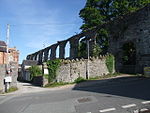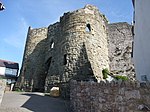Howell's School, Denbigh
Howell's School Denbigh (Welsh: Ysgol Howell Dinbych) was a private girls only school located in Denbigh, Denbighshire. A new co-educational independent school, Myddelton College, opened on the site in 2016.The school taught girls from the age of 3 up to 18 and contained a pre-preparatory, preparatory, senior and sixth form. It was established in 1859 with funding from Thomas Howell's trustees who later established Howell's School Llandaff in 1860. The school had many facilities including a sports hall, 120 acres of grounds and an equestrian centre. In the 2011 Daily Telegraph Independent League Table of GCSE results, Howell's School came 298th in the UK with 22.03% A* Grade and 45.79% A* or A grade.Following some years of decline in numbers and a series of tribunals involving staff wrongfully dismissed amid allegations of poor management, the school announced on 2 August 2013 that it would not be reopening for the following academic year, citing financial difficulties as the primary reason, although this is disputed. The school went into liquidation on 22 August 2013 following a meeting with creditors.
Excerpt from the Wikipedia article Howell's School, Denbigh (License: CC BY-SA 3.0, Authors).Howell's School, Denbigh
Park Street,
Geographical coordinates (GPS) Address Nearby Places Show on map
Geographical coordinates (GPS)
| Latitude | Longitude |
|---|---|
| N 53.184217 ° | E -3.41531 ° |
Address
Park Street
LL16 3DD , Denbigh
Wales, United Kingdom
Open on Google Maps










